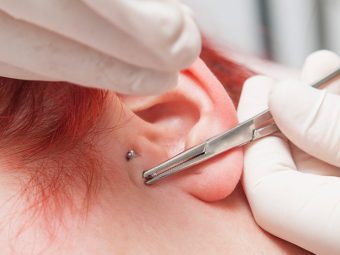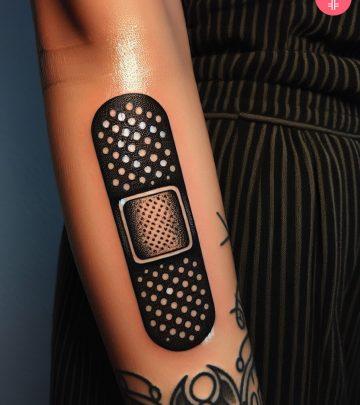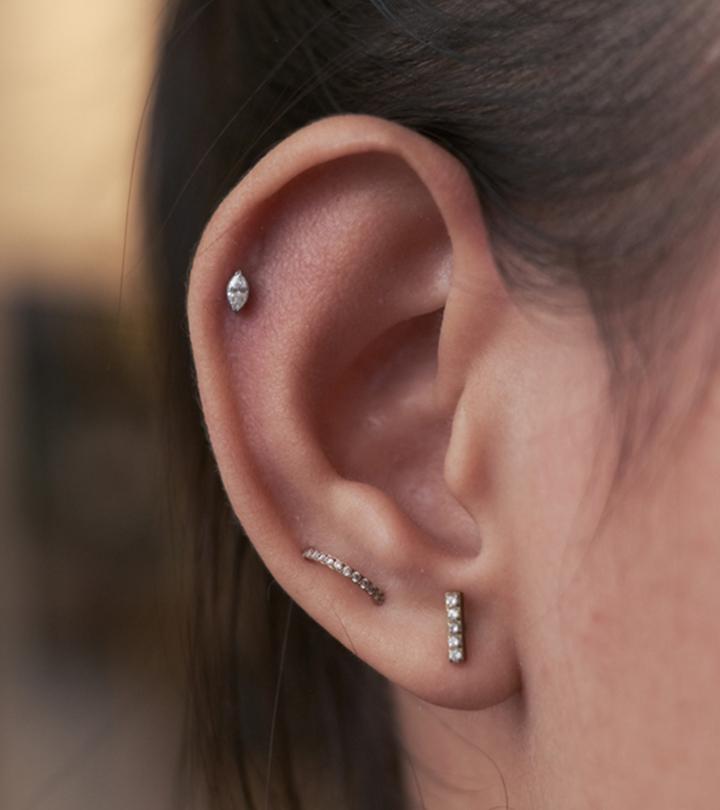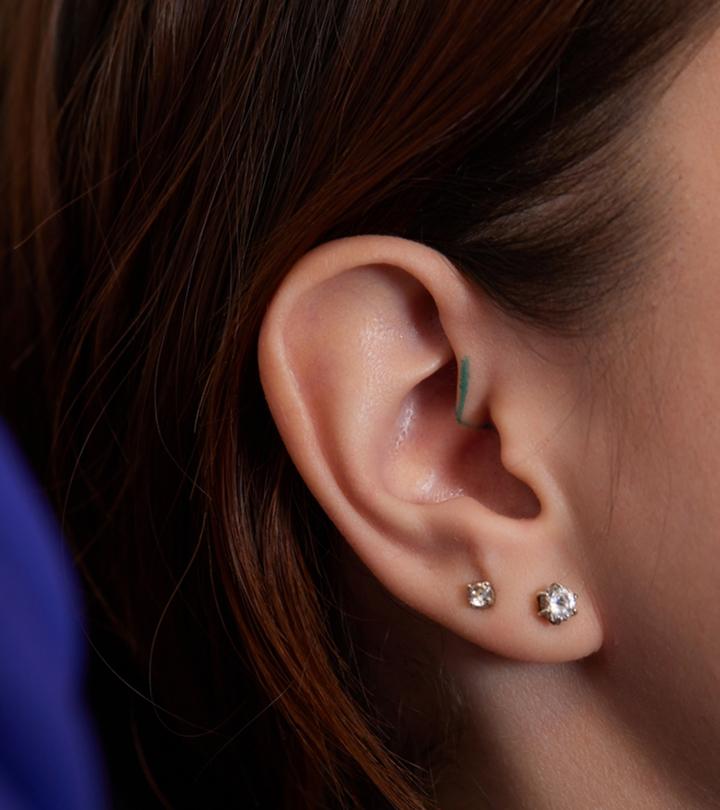Infected Lip Piercing: What Does it Look Like & How To Treat
Take care of your piercing and learn ways to deal with potential infections effectively.

Image: Shutterstock
Dealing with an infected lip piercing can be a worrisome experience, but it is a common situation many people face after taking the bold step to accessorize their pout. A lip piercing may add a striking touch to your appearance, but it is not without potential complications. It is essential to recognize the signs of infection early on and swiftly take the proper steps to address the issue. This not only ensures a quick return to your stylish look but also prevents any serious health concerns that could arise from an untreated infection. In this article, we will delve into the typical appearance of an infected lip piercing and examine effective treatment strategies to handle this problem. Scroll down to learn all about how to take care of your lip piercing.
In This Article
Types Of Lip Piercings
Each piercing offers a way to personalize your style and make a fashionable statement. If you are considering getting a lip piercing, below is a guide to the types available.
- Labret Piercing: It is found just below the bottom lip and is a simple and classic style.
- Philtrum/Medusa Piercing: It is located directly above the upper lip and offers a centered and balanced look.
- Monroe Piercing: This style is placed on the left upper lip to imitate Marilyn Monroe’s famous beauty mark.
- Madonna Piercing: This design is inspired by pop icon Madonna and features a similar style to the Monroe but on the right side.
- Vertical Labret Piercing: This style runs vertically from the top to the bottom of the lower lip for a standout appearance.
- Jestrum Piercing: The piercing is similar to a vertical labret but is placed on the upper lip.
- “Bite” Piercings: This includes styles like Snake Bites, Dolphin Bites, and Spider Bites, which feature dual piercings on different parts of the lips for a more distinctive look.
 Trivia
TriviaNo matter which type of lip piercing you opt for, it is critical to follow thorough aftercare routines to prevent any possibility of infection. An infected lip piercing can occur if the area is not properly cleaned or cared for, turning a stylish statement into a health hazard that requires prompt attention and treatment. Learn more about the different signs of infected lip piercings in the section below.
What Does An Infected Lip Piercing Look Like?

Spotting an infected lip piercing early on is key to quick and effective treatment. An Here’s a breakdown of the signs exhibited by an infected lip piercing to help you identify:
- Redness: The skin around the piercing site may appear redder than usual, which is a common initial sign of infection. This can extend beyond the immediate area of the piercing and may not subside with time as it would with normal healing.
- Swelling: Swelling is a common symptom along with redness. The area may look puffed up and feel tight. Swelling can also cause the jewelry to feel uncomfortably snug and may even imprint the pattern of the jewelry on the swollen skin. If you experience excessive swelling, this could indicate an issue beyond the minor swelling often seen with new piercings. Keep track of the recovery time; if it extends significantly, this might be a symptom of a developing problem.
- Warmth: When touching the area around the piercing, it might feel warmer compared to other parts of your skin, suggesting inflammation. This heat is a response from your body as it attempts to fight off the bacteria causing the infection.
- Pain: Any significant increase in pain or a throbbing sensation around the piercing site could point to an infection. Pain may persist even without movement, and you might find that it intensifies when the area is touched or during facial expressions.
- Discharge: An infected lip piercing might ooze yellow or greenish pus, which is not to be confused with the clear or white fluid excretion that’s normal during the healing process. This discharge is a collection of white blood cells, bacteria, and dead tissue, indicating that your body is trying to fight off an infection (1).
- Foul Smell: The discharge may have an unpleasant odor, which is a definite red flag. The smell is caused by the presence of bacteria and dying cells within the discharge, and it is quite distinct from the normal scents of your body.
- Difficulty In Movement: If the infection is advanced, you may find it painful to move your mouth, smile, or chew. This can interfere with everyday activities such as talking and eating, significantly impacting your daily comfort and quality of life and even causing tooth damage (2).
If these symptoms are present, it is crucial to seek professional advice promptly. Early intervention can prevent the infection from worsening and promote proper healing, allowing you to enjoy your lip piercing without further issues. It is essential to know about what causes these infections. Scroll down to read more about it.
Causes Of Lip Piercing Infection
When you have a stylish lip piercing, the last thing you want is an infection to spoil the fun. Knowing what can lead to an infected lip piercing helps you stay ahead of the game and keep your piercing looking great.
- Bacterial Infection: The mouth’s natural bacteria can easily contaminate a fresh piercing, especially if the wound is not cleaned regularly. It is important to engage in proper cleaning practices to prevent the rapid multiplication of bacteria. Failure to do so can lead to redness, swelling, and pus formation. Good oral hygiene and regular rinsing with saline solution can help combat these issues.
- Improper Piercing Technique: A piercing done without sterile equipment can introduce harmful pathogens to the wound. It is essential that your piercer uses single-use, disposable needles and wears gloves to prevent cross-contamination. Always look for a reputable piercing studio with high standards for cleanliness and safety.
- Handling With Dirty Hands: Our hands touch countless surfaces throughout the day, picking up germs that can be transferred through a piercing. If you must touch the area for cleaning purposes, it is wise to avoid fiddling with your jewelry and to clean your hands before touching. Educate friends and family about the risks of touching your piercing to minimize infection risks.
- Allergic Reactions To Jewelry: Non-hypoallergenic materials like nickel can irritate the skin and mimic infection symptoms. Opting for jewelry made from titanium or 18k gold can help avoid these reactions (3). Pay attention to your body’s response to the jewelry and consult with your piercer if you notice persistent irritation.
- Aftercare Neglect: Following your piercer’s aftercare instructions is crucial for the healing process. Ignoring these steps can slow down healing and open the door to infections. Regular saline washes and avoiding harsh cleaning agents will aid in proper healing and avoiding irritation (4).
- Contaminated Water Exposure: Freshwater bodies harbor microorganisms that can infect a piercing. Similarly, chlorinated pools and hot tubs can also irritate the piercing site and disrupt the healing process (5). It is best to avoid swimming until your piercing has fully healed to prevent these risks.
- Oral Contact: When you share utensils or engage in intimate kisses, it can introduce new bacteria to your piercing. Be mindful of what comes into contact with your mouth area, and avoid sharing drinks or food while your piercing is healing. Keeping your own oral hygiene in check is equally important, so brush and floss regularly, and use alcohol-free mouthwash.
By keeping these points in mind, you can ensure a smoother healing process for your lip piercing, and reduce the likelihood of encountering complications like infections. However, if you already have an infected lip, you should be aware of how to treat it. Check below for details.
How To Treat An Infected Lip Piercing
Dealing with an infected lip piercing requires patience and attention to detail. Here’s a breakdown of the treatment steps to ensure proper healing:
- Maintain Cleanliness: Ensuring that the area around your infected lip piercing is clean is crucial. Use a salt solution to cleanse the piercing hole twice daily, which can significantly enhance the healing piercing process and reduce the risk of complications. Make this cleaning routine a regular part of your morning and evening to give your piercing the best chance to heal.
- Retain The Jewelry: Keeping the jewelry in your piercing is essential, as it not only acts as a conduit for drainage but also ensures the infection has a way to exit the body. If the jewelry is removed too soon, the piercing can close up rapidly, trapping the infection inside and potentially leading to more complex issues, such as more intense infections or cysts. Always consult with a piercing professional before making any changes to your jewelry, especially when dealing with an infected lip piercing, as they can provide alternatives that maintain the piercing’s integrity while addressing your comfort concerns.
- Use Over-The-Counter Pain Relief: Over-the-counter (OTC) pain relief is beneficial for easing the discomfort associated with an infected lip piercing, allowing you to focus on the healing rather than the pain. However, it is important to use these medications as directed and not to exceed the recommended dosage. While they help with symptomatic relief, they do not address the root cause of the infection, so using them in conjunction with proper cleaning and care is vital for full recovery.
- Apply Topical Antibiotics: If you are noticing persistent signs of infection around your facial piercings, it is crucial to introduce an antibiotic ointment to your aftercare regimen. Topical antibiotics can be a useful ally in the fight against infection, but they must be applied correctly to be effective. A thin layer of ointment should be applied around the piercing jewelry to prevent the further infection buildup. Wash your hands thoroughly with soap and water before application. Gently pat dry the area after cleansing to ensure the ointment can penetrate the skin. Additionally, be mindful to apply the ointment only as often as a doctor recommends, as overuse can hinder the natural healing process and potentially lead to further complications.
- Rinse With Alcohol-Free Mouthwash: Choose a mouthwash that is designed for oral wounds or post-dental work, as these are often gentler and formulated for healing tissues. Consistent rinsing after meals can prevent leftover food particles from aggravating your piercing.
- Avoid Irritants: Avoid spicy food as it can irritate the piercing site. Consistently following your aftercare regimen is key to preventing excessive bleeding, a sign that the piercing may be aggravated or infected. Apart from food and hot drinks, also be mindful of oral habits like nail-biting or pencil-chewing that can introduce bacteria. It is best to cut these out of your routine while your piercing is healing.
- Seek Medical Attention When Necessary: Do not wait for the infection to become severe before seeking help. Early intervention by a healthcare professional can prevent more serious complications, and ensure a faster return to health.
- Practice Good Oral Hygiene: Besides your regular hygiene routine, consider using a new toothbrush after getting a piercing to reduce the introduction of bacteria. Rinsing your mouth with water after consuming snacks and drinks can also help to keep your oral environment clean. Remember, when you brush, be gentle around the piercing site to avoid irritation and promote healing. Additionally, if you use mouthwash, avoid vigorous swishing, which can cause further distress to the area.
 Did you know?
Did you know?In summary, being proactive and attentive with the aftercare of an infected lip piercing is key. By ensuring proper hygiene, medication, and guidance, you can confidently enjoy your lip piercing as it heals. Remember, the goal is to heal the infection without hindering the piercing’s healing process, or your overall oral health. We turn to home remedies as the first option to heal infected piercings. In the next section, we have discussed the common home remedies that can help with an infected lip piercing.
Home Remedies To Heal An Infected Lip Piercing

Tackling an infected lip piercing at home involves a mix of simple yet effective remedies that complement your usual care routine. Here are some additional points to consider:
- Ice Therapy: Gently applying a cold compress or ice wrapped in a clean cloth can offer immediate relief by reducing swelling, inflammation, and numbing the pain (6). It is a temporary measure that can make you more comfortable, especially when the piercing feels particularly tender. The homemade compress calms the healing tissue around the piercing. This can be especially beneficial for those with lower pain tolerance, and can help to prevent skin infections.
- Saltwater Solution: Rinsing with a saltwater solution, made by dissolving a pinch of sea salt in warm distilled water, can flush out bacteria and keep the pierced area clean (7). This is especially crucial after meals or snacks to prevent residual food particles from aggravating the piercing.
- Warm Compress: Applying a warm compress can encourage circulation to the area, facilitating the natural healing process and helping any trapped fluid drain more effectively (8). Make sure the compress is not too hot to avoid burning the sensitive skin around the piercing.
Remember, while home remedies can provide temporary relief and support the healing of an infected lip piercing, they should be used in conjunction with proper piercing aftercare practices. If you are freshly pierced and wondering what can be done to avoid an infection, scroll down to read about ways to prevent lip piercing infection.
Prevention Of Infected Lip Piercing
Preventing an infected lip piercing starts with a mindful approach right from the moment you decide to get pierced. Here are some key strategies to keep in mind to maintain the health and beauty of your lip piercing:
- Choose a Reputable Piercer: The journey to healthy piercing begins with a professional who understands the importance of sterilization and proper technique. Research and select a piercing studio that has sterling reviews for cleanliness and safety protocols as well as experts on board.
- High-Quality Jewelry: Invest in jewelry made from materials less likely to cause irritation or allergic reactions, such as gold or surgical steel (3). Quality jewelry can make a significant difference in how your piercing heals.
- Follow Aftercare Instructions: Your piercer will give you a set of aftercare instructions—follow them to the letter. It is important to use a cotton ball or a clean gauze pad soaked in a distilled water saline solution to remove any foreign objects or buildup that might occur around the jewelry. This step is essential in avoiding severe infections, which can jeopardize not just the piercing but your overall oral health. If you are uncertain or uncomfortable at any point, it is always best to consult a healthcare professional.
- Hands Off: It is important to avoid touching or playing with a new piercing. Your hands carry a host of bacteria that can lead to an infected lip piercing. Keep your hands clean and away from your piercing.
- Oral Hygiene: Keep your mouth clean by brushing and flossing regularly and using an alcohol-free mouthwash. This will help reduce the risk of introducing oral bacteria to your piercing. If you have an inner lip piercing, rinsing with an antibacterial mouthwash free of alcohol can help maintain good oral health and reduce the chances of developing gum disease related to the piercing.
- Be Mindful Of Activities: Engaging in certain activities, such as swimming in public pools or contact sports, may increase the risk of infection. Consider your lifestyle and take the necessary precautions to protect your piercing as it heals.
Taking these proactive steps can help you enjoy your lip piercing without the worry of infections, ensuring that your self-expression through body art remains a joyful and healthy experience.
It is clear that taking care of a lip piercing is no small feat. It requires dedication from the moment of piercing through the entire healing process. It is also important to select a qualified piercer, use high-quality jewelry, and follow good aftercare practices to guarantee a successful healing process after the piercing. Remember, if you notice any signs of infection, do not hesitate to reach out to a professional. It is important to take the necessary precautions and properly care for the lip piercing to ensure it stays healthy and infection-free. By doing so, you can confidently display your new piercing without any concerns. Here is to your piercing adding just the right edge to your style, safely and beautifully!
Frequently Asked Questions
Do lip piercings get infected easily?
Yes. Lip piercings can be prone to infection if not cared for properly due to the high bacteria levels in the mouth.
Is it normal for a lip piercing to form pus?
Yes. Some discharge, including pus, can be normal in the early stages of healing, but if it continues, it may indicate an infection, and you should consult a professional.
How long does it take for a lip piercing infection to heal?
The healing time for a lip piercing infection can vary, but with proper care, it typically takes a few weeks to heal fully.
Key Takeaways
- Infected lip piercings exhibit redness, swelling, warmth, pain, discharge, odor, and movement difficulty.
- Causes include poor hygiene, unsterile piercing methods, touching with dirty hands, and allergic reactions.
- Treat infections with saline cleanses, keeping the jewelry in, over-the-counter pain relief, and medical advice.
- Home remedies like cold compresses and saltwater rinses can aid healing alongside managing symptoms.
- Prevent infections by choosing reputable piercers, using quality jewelry, and following thorough aftercare.
Infected lip piercings are a nightmare to live with. It hurts to drink, eat, or even smile. Learn how to take care of your infected lip piercing with the help of this informative video for an easy return to normalcy.
References
Articles on StyleCraze are backed by verified information from peer-reviewed and academic research papers, reputed organizations, research institutions, and medical associations to ensure accuracy and relevance. Read our editorial policy to learn more.
- Oral And Facial Piercing: Associated Complications and Clinical Repercussions
https://www.researchgate.net/profile/Maria-Jose-Vallejo-2/publication/5304132_Oral_and_facial_piercing_Associated_complications_and_clinical_repercussion/links/586e77fc08ae8fce491bd429/Oral-and-facial-piercing-Associated-complications-and-clinical-repercussion.pdf - Periodontal Health And Lateral Lower Lip Piercings: A Split-Mouth Cross-Sectional Study
https://onlinelibrary.wiley.com/doi/abs/10.1111/j.1600-051X.2009.01431.x - Jewelry for Initial Piercings
https://safepiercing.org/jewelry-for-initial-piercings/ - Self-Reported Complications With Lip And Tongue Piercing
https://openurl.ebsco.com/EPDB%3Agcd%3A12%3A10514908/detailv2?sid=ebsco%3Aplink%3Ascholar&id=ebsco%3Agcd%3A53883573&crl=c - Infections Acquired via Fresh Water: From Lakes to Hot Tubs
https://journals.asm.org/doi/10.1128/microbiolspec.iol5-0019-2015 - The Effect of Soft Tissue Injury Cold Application Duration on Symptoms Edema Joint Mobility and Patient Satisfaction: A Randomized Controlled Trial
https://www.sciencedirect.com/science/article/abs/pii/S009917672030060X# - Rinsing with Saline Promotes Human Gingival Fibroblast Wound Healing In Vitro
https://www.ncbi.nlm.nih.gov/pmc/articles/PMC4956236/ - The Effect of Warm Moist Compresses in Peripheral Intravenous Catheter-related Phlebitis
https://www.sciencedirect.com/science/article/abs/pii/S1462388923001722





























